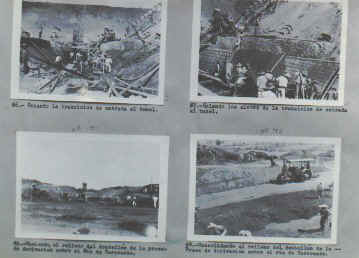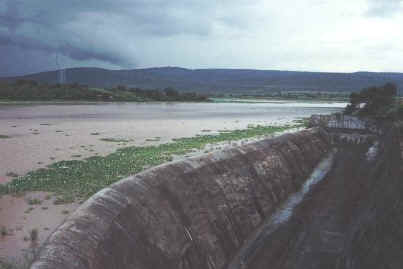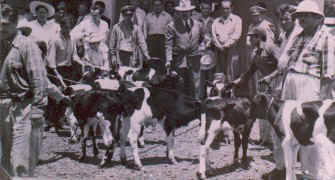 Constructing a new irrigation system, 1938
Constructing a new irrigation system, 1938 Constructing a new irrigation system, 1938
Constructing a new irrigation system, 1938
In the Ciénega, the ejido became the principal form of land tenure. The campesinos received not merely land of the highest commercial quality, but water with which to irrigate a substantial proportion of that land. Major new investments were made in the irrigation infrastructure in the 1960s and 1970s, and this is the kind of region in which the ejidos theoretically had most to gain from the renewed support which the national state began to offer peasant agriculture from the administration of Díaz Ordaz through the apogee of state intervention under the governments of Luis Echeverría (1970-1976) and his successor José López Portillo (1976-1982).
Lázaro Cárdenas himself showed a renewed interest in channelling resources to the Ciénega in the two years before his death in 1968. This, then, is not an area where peasant farmers were left to eke out a living on marginal land, with no practical alternative but to grow corn and beans to supplement family subsistence. The areas of land assigned to each ejidatario, four hectares of irrigated land or eight of temporal, whilst perhaps not generous, were envisaged by the reformers as providing a basis for a self-sustaining small-farming enterprise rather than as a supplement to the wage on the model of the smaller, rain-fed, plots allocated to beneficiaries in other regions such as the State of Mexico.
The dam at Jaripo
This video clip illustrates modern subsistence cultivation in the rocky upland fields known as ecuaros. This large ecuaro belongs to the leader of the Guaracha ejido in 1982, who had the financial wherewithal to hire non-family labour to work on his maize. This is one of the better fields, closer to the valley floor overlooking the old sugar mill, and has been cleared of rocks sufficiently to permit cultivation with the plough. Nevertheless, as the clip shows, plough cultivation even of a good quality terraced upland field is still very hard work. The owner is working with his younger brother and his young children are also helping. The clip opens with shots of the hired hands weeding the maize with machetes. People with poorer quality fields have to perform all the cultivation on their ecuaros by hand, and restrict themselves to family labour, if it is available. By the 1980s, many younger people regarded the cultivation of ecuaros as no longer worth the effort because of declining yields. In this case, however, the owner could invest in fertiliser as well as hire extra labour. He was able to produce a surplus for sale in the community as well as meet his family's needs for an entire year. (Super-8 movie footage transferred to video, no sound.) Click on the Quicktime logo to see the video.

Lázaro Cárdenas promoting a scheme to create ejido dairy herds with improved bloodstock, 1966